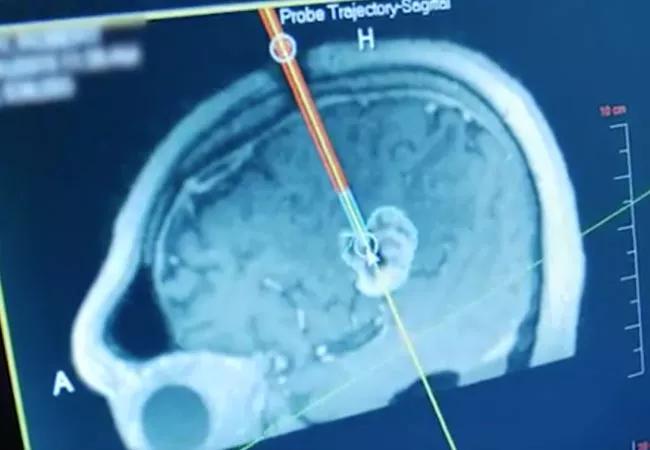Extent of ablated tumor coverage is a significant prognostic factor

For patients with newly diagnosed glioblastoma (nGBM) unable to undergo surgical resection, laser ablation (LA) plus chemoradiation therapy (CRT) offers efficacy comparable to that of biopsy plus CRT. So finds the first study to evaluate LA therapy in this setting, a multicenter retrospective investigation led by Cleveland Clinic researchers and published online by Neurosurgery November 23.
Cleveland Clinic is a non-profit academic medical center. Advertising on our site helps support our mission. We do not endorse non-Cleveland Clinic products or services. Policy
“Survival outcomes related to progression of disease among patients who received laser ablation therapy were better than those in the matched biopsy group,” says the study’s lead investigator, Cleveland Clinic neurosurgeon Alireza Mohammadi, MD. “This adds to a growing body of evidence that laser ablation is a reasonable and effective minimally invasive strategy for patients with newly diagnosed glioblastoma who are not suitable candidates for traditional surgery.”
Standard treatment of nGBM consists of surgical resection followed by CRT. But for tumors located in eloquent areas or too deep to be resected, biopsy plus CRT is considered a reasonable management strategy, although it results in suboptimal outcomes.
LA therapy, also known as laser interstitial thermal therapy (LITT), is increasingly used as a minimally invasive alternative to treat deep-seated brain tumors and recurrent GBM. Its role as initial therapy for glioblastoma has not been established, prompting the current investigation.
For the study, Dr. Mohammadi and his Cleveland Clinic colleagues partnered with researchers at three other major U.S. centers to review outcomes among 24 patients with nGBM who underwent upfront LA therapy at these institutions between June 2011 and December 2014. These individuals were matched to 24 comparable patients with nGBM who had undergone biopsy followed by CRT. The groups were matched by age, gender, tumor location and tumor volume.
Median overall survival was found to be 14.4 months in the LA group vs. 15.8 months in the biopsy group, and median progression-free survival was 4.3 months vs. 5.9 months in the LA and biopsy groups, respectively. These differences were not statistically significant.
However, significant differences did arise when the LA therapy group was broken down by extent of tumor coverage by thermal-damage-threshold lines, a measure of how completely tumors were ablated. Multivariate analyses revealed a significantly lower incidence of disease-specific death and progression among patients in the LA group who achieved optimal coverage compared with both the LA therapy patients who had less favorable coverage and to patients in the biopsy group, after adjusting for age, gender, tumor location and tumor volume.
Additionally, smaller tumor volume (< 11 cc) was found to be a beneficial prognostic factor for overall survival, as was younger age (< 70 years).
In invited comments at the end of the Neurosurgery study report, practitioners from Miami not involved in the study noted that “the authors’ findings that maximal ablation portends an improved prognosis suggest that patient selection remains critical, i.e., LITT should be reserved for lesions that can be ablated favorably.”
Dr. Mohammadi concurs. “Patient selection is a crucial consideration with any treatment modality, and laser ablation is no exception,” he says. “We shouldn’t select patients for laser ablation just because they are not candidates for open surgery. Indeed, the reason we do research like this is to identify the group of patients who benefit the most from a given procedure. One of the most important factors is whether or not the lesion is amenable to optimal ablation.”
Dr. Mohammadi adds that LA therapy might offer advantages to biopsy beyond reduced invasiveness. Because the surgical incision for LA therapy is smaller than that for resection, CRT can potentially be started earlier for patients undergoing ablation. Additionally, animal and human studies indicate that hyperthermia temporarily disrupts the blood-brain barrier, potentially enhancing the efficacy of follow-up CRT
“This is the subject of one of our ongoing trials, in which we are trying to do expedited chemo/radiation after biopsy and laser ablation for newly diagnosed high-grade glioma, to take advantage of possible blood brain barrier disruption,” he explains.
The current study’s findings “suggest that a cytoreductive benefit can be achieved with laser ablation, even for deep-seated tumors typically thought to be unresectable,” notes another invited comment at the end of the Neurosurgery publication, from a practitioner in Detroit not involved with the study. “Based on this interesting data, prospective comparative multi-institutional studies should proceed.”
Dr. Mohammadi and his co-authors note that their study’s retrospective design and small size limits generalizability of its findings. Also, molecular factors, such as the presence of isocitrate dehydrogenase (IDH) mutations and 06-methylguanine-DNA methyltransferase (MGMT) promoter methylation, were not available for all patients, potentially skewing results.
A follow-up prospective multicenter study is underway that’s expected to be completed after about two years.
“We hope to address the limitations of our first study and further refine the role of laser ablation therapy for newly diagnosed glioblastoma with nonresectable lesions,” says Dr. Mohammadi. “An effective minimally invasive treatment is a welcome addition to our armamentarium against this difficult disease.”

An underdiagnosed condition in patients with cancer

Study demonstrates superior visualization of occult primary lesions

New device offers greater tumor control for malignant liver lesions

Cleveland Clinic researchers discover what drives – and what may halt – virus-induced cancer

First-ever U.S. population-level retrospective analysis reveals many patients with systemic mastocytosis need faster intervention

New program provides prehabilitation and rehabilitation services to help patients with cancer maintain and regain function

First-of-its-kind research investigates the viability of standard screening to reduce the burden of late-stage cancer diagnoses

Global R&D efforts expanding first-line and relapse therapy options for patients